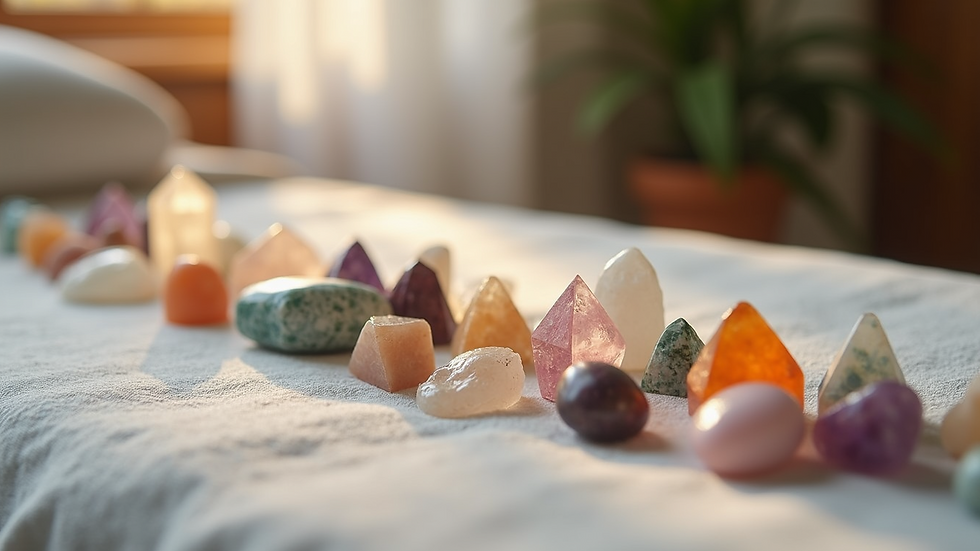Hands-On Skills for a Career in Massage Therapy
- Alyra Beaumont

- Oct 23
- 4 min read
Embarking on a career in massage therapy opens a world of healing, connection, and personal growth. For those already versed in holistic practices like yoga, sound therapy, or shamanic healing, adding massage therapy to your skillset can deepen your ability to support others physically and emotionally. This guide explores the essential hands-on skills you need to thrive in this rewarding profession.
Essential Massage Therapy Techniques to Master
Massage therapy is a practical art that requires both knowledge and skill. To become proficient, focus on mastering these core techniques:
Swedish Massage: This foundational technique uses long, gliding strokes, kneading, and circular movements to relax muscles and improve circulation. It’s ideal for beginners to learn muscle anatomy and client communication.
Deep Tissue Massage: This involves applying firm pressure to reach deeper layers of muscle and fascia. It’s effective for chronic pain and tension but requires precise control to avoid discomfort.
Trigger Point Therapy: Identifying and releasing tight knots or “trigger points” helps alleviate referred pain. This technique demands a sensitive touch and understanding of pain referral patterns.
Myofascial Release: Gentle sustained pressure on connective tissue improves mobility and reduces pain. It’s a subtle technique that enhances body awareness.
Lymphatic Drainage: Light, rhythmic strokes encourage lymph flow and detoxification. This technique supports immune function and is often used post-surgery or for chronic swelling.
Practice these techniques regularly on different body types to develop confidence and adaptability. Use props like massage tables, bolsters, and oils to create a comfortable environment for your clients.

Building Client Communication and Assessment Skills in Massage Therapy
Effective communication is as important as technical skill in massage therapy. Before you begin any treatment, you must assess your client’s needs and health status. Here’s how to build these skills:
Initial Consultation: Ask open-ended questions about medical history, pain areas, lifestyle, and goals. This helps tailor the session and ensures safety.
Body Language Awareness: Pay attention to non-verbal cues like muscle tension, breathing patterns, and facial expressions during the massage.
Feedback During Treatment: Encourage clients to speak up if pressure is too much or if they feel discomfort. Adjust your technique accordingly.
Post-Session Advice: Offer guidance on stretches, hydration, and self-care to prolong benefits.
Developing empathy and active listening skills will create trust and encourage repeat bookings. Remember, massage therapy is a partnership between therapist and client.
How long does it take to become a massage therapist in NY?
In New York, becoming a licensed massage therapist typically requires completing a minimum of 500 hours of education from an accredited school. This includes both classroom instruction and hands-on practice. The curriculum covers anatomy, physiology, pathology, ethics, and various massage techniques.
After completing the coursework, candidates must pass the Massage & Bodywork Licensing Examination (MBLEx) or a state-approved alternative. The entire process usually takes between 6 months to 1 year, depending on whether you study full-time or part-time.
Continuing education is also essential to maintain licensure and stay updated on new techniques and regulations. Many therapists choose to specialise further in areas like sports massage, prenatal massage, or oncology massage.

Practical Tips for Excelling in Massage Therapy Classes
Choosing the right training program is crucial. Look for courses that offer a balance of theory and extensive practical experience. Here are some tips to get the most out of your massage therapy classes:
Engage Actively: Participate fully in hands-on sessions. Practice on classmates and volunteers to build confidence.
Ask Questions: Clarify doubts about anatomy, techniques, or client management early on.
Use Visual Aids: Study diagrams, videos, and models to understand muscle groups and body mechanics.
Practice Self-Care: Massage therapy can be physically demanding. Learn proper body mechanics to protect yourself from injury.
Network: Connect with instructors and peers. They can be valuable resources for job leads and ongoing support.
If you’re ready to start your journey, consider enrolling in massage therapy classes that offer comprehensive training tailored to holistic therapists.
Integrating Massage Therapy into Your Holistic Practice
Once you have developed your hands-on skills, integrating massage therapy into your existing holistic practice can enhance your offerings and client outcomes. Here’s how to do it effectively:
Create Combined Sessions: Blend massage with yoga, sound therapy, or energy healing for a unique experience.
Offer Workshops: Teach self-massage techniques or partner with other therapists for group events.
Promote Your Services: Use social media, local directories, and your network to reach potential clients.
Join a Therapist Directory: Listing your services on platforms dedicated to holistic therapies increases visibility.
Host Spiritual Development Groups: Invite clients to join Sunday evening gatherings that complement physical healing with emotional and spiritual growth.
By positioning yourself as a versatile holistic therapist, you attract clients seeking comprehensive wellness solutions.

Continuing Your Journey in Healing and Growth
Massage therapy is more than a career - it’s a path of continuous learning and personal transformation. As you deepen your skills, consider exploring specialised modalities or advanced certifications. Attend workshops, read widely, and connect with other healers to expand your knowledge.
Your hands have the power to ease pain, reduce stress, and restore balance. Embrace this gift with dedication and compassion. Whether you work in a clinic, run your own practice, or collaborate with other holistic therapists, your journey in massage therapy will enrich both your life and the lives of those you serve.
Take the next step today by joining a community of like-minded healers and enrolling in quality training. Your future as a skilled massage therapist awaits.
.png)







Comments